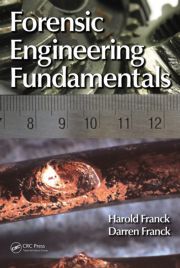
Forensic Engineering Fundamentals - Franck

Descripción
Descripción completa de: Forensic Engineering Fundamentals - Franck
Author: Harold Franck, Darren Franck
Language: English
Finishing: Hardcover, 487 pages
ISBN: 978-1-4398-7839-2
Edition Number: December 2012
Description:
Forensic engineers often specialize in a particular area such as structures, fires, or accident reconstruction. However, the nature of the work often requires broad knowledge in the interrelated areas of physics, chemistry, biomechanics, and engineering. Covering cases as varied as assessment of workplace accidents to the investigation of Halliburton in the BP oil spill, Forensic Engineering Fundamentals is a comprehensive introduction to the many diverse facets of the field that forensic engineers must be familiar with in their practice.
Features:
- Incorporates the fundamental issues encountered by the practicing forensic engineer
- Examines civil, structural, and environmental principles
- Explores the role of the forensic engineer in accident reconstruction
- Discusses fires and electrical incidents
- Covers probability and uncertainty detailing basic calculations
- Emphasizes relevant standards and codes
- Provides current case studies to clarify concepts
Table of Contents:
- Introduction
- Structural Distress
- Substandard Design and Construction
- Some Structural Basics
- Structures: Mechanics and Force Systems
- Newton’s Laws and Equilibrium
- Work and Energy: Conservation Principles
- Properties of Areas
- Structures
- Mechanics or Strength of Materials
- Allowable Stress and Strength Design Methods
- Chimney Damage
- Truss Analysis
- Example: Truss Failure
- Dynamic Loading
- Wind Damage
- Snow, Hail, and Rain
- Stresses on Cylindrical Pressure Vessels
- Load Analysis on Pilings
- Strain
- Foundations
- Blasting and Earth Movement
- Introduction to Soil Behavior
- Techniques of Subsurface Investigations
- Landslides
- Identification of Rocks
- Supporting Capacity of Earth Formations
- Stability of Natural Slopes
- Atterberg Limits
- Subsidence
- Earthquakes
- Foundations
- Blasting Damage
- Heavy Equipment Vibrations
- Wave Pressure
- Mold and Environmental Problems
- Airborne Particles
- Mold
- Radon
- Gases
- Ventilation
- Building Materials
- Asbestos
- Electromagnetics
- Vibrations and Sound
- Temperature
- Ergonomics and Illumination
- Water-Related Losses
- Fluid Statics and Dynamics
- Open Channel Flow
- Hydrology and Water Runoff
- Groundwater
- Plumbing and Fittings
- Water Hammer
- Soils and the Water Table
- Appliances and Equipment Failures
- Kitchen and Household Appliances
- HVAC Systems
- Pumps, Generators, and Motors
- Boilers
- Dissolution of Aluminum
- Welding Failures
- Cars
- Interpreting Electrical Activity
- Component Fracture Mechanics
- Gouge Spacing
- Broken Pole Analysis
- Slips and Falls
- Walkway Safety
- Standard of Care
- American Disabilities Act
- Testing of Slip Resistance of Walking Surfaces
- Force Required to Pull a Dolly
- Biomechanics of Falls
- Sight Distance for Pedestrians
- Pedestrians and Trains
- Departure Sight Distance Calculations
- Moving Vehicle Sight Distance Calculations
- Calculation of Train Speed
- Human Injuries and the Strength of Human Tissue
- Bone Fractures
- Transverse Fracture of Long Bones
- Head Injury
- Head Injury Criterion
- Compilation of Studies Involving Occupant Kinematics and Vehicle Impacts
- Biomechanics of Injury
- Vehicular Collisions with Pedestrians or Bicyclists
- Internal Organ Injuries
- Knee Injuries
- Injuries of the Hand, Wrist, and Elbow
- Teeth Injuries
- Lower Leg Injuries
- Shoulder Injuries
- Hip Injuries
- Industrial and Construction Accidents
- Equipment Losses
- Injuries and Death
- Accident Reconstruction
- Introduction
- Basic Principles of Physics
- Introduction to Energy Methods
- Momentum Methods
- Electrical Incidents and Lightning
- Electrical Distribution Systems
- Some Basic Equations
- Switch Failure
- Current in a Bus Bar
- Current in a Solid Wire Conductor
- Testing of Transistors and Electrical Components
- Lightning
- Impulse Voltages
- Electrocutions
- Low-Voltage Electrocutions
- Swimming Pool Electrocutions
- Animal Testing
- Medium-Voltage Electrocutions
- High-Voltage Electrocutions
- Human Conductivity
- Response of Human Tissue to Electrical Stimulation
- Electrical Modeling of the Human Body
- Fires
- Thermodynamic Principles
- Systems and Processes
- Zeroth Law of Thermodynamics
- Enthalpy
- Combustion
- Hydrocarbons
- Explosive Limits
- Flash Points
- Transfer of Heat
- First Law of Thermodynamics
- Second Law of Thermodynamics: Entropy
- Heat Flow
- Explosive Characteristics
- Flow of Gas through a Pipe
- Thermal Conductivity, Convectivity, and Radiation
- Gas Can Burn
- Live Burns
- House Fires
- Car Fires
- Miscellaneous Losses
- Carbon Monoxide
- Chains and Hooks
- Examination of Vehicle Lightbulbs and Filaments
- Defeating Locks
- Vehicle Computer Interrogation
- Engine Wear
- Fire Suppression Systems
- Probability, Sensitivity, and Uncertainty
- Sensitivity and Uncertainty
- Probability and Statistics
- Standards
- Protocol for Forensic Investigations
- Standard Guide for Forensic Engineering Inspections and Investigations
- ASTM Standards
- FMV Standards
- SAE Standards
- Relevant Construction Standards
- NFPA Standards
- International Standards
- Appendix A: Values of Fundamental Constants (MKS Units)
- Appendix B: Acronyms
- Appendix C: Conversion Factors
- Bibliography
Puedes encontrar este libro tambien en las siguientes categorías

































Valoración: